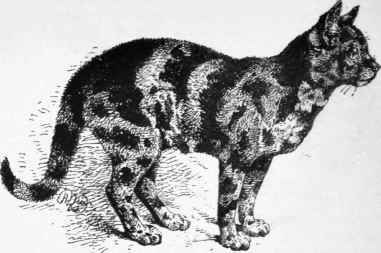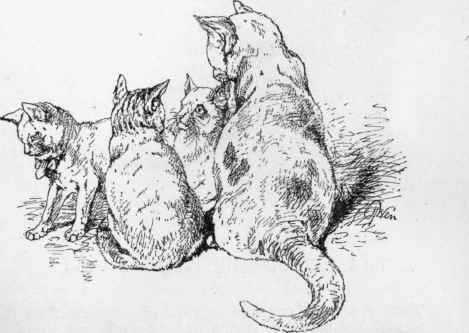The Tortoiseshell Cat
Description
This section is from the book "Our Cats And All About Them", by Harrison Weir. Also available from Amazon: Our Cats And All About Them.
The Tortoiseshell Cat
I now come to the section of the short-haired domestic cat, a variety possessing sub-varieties. Whether these all came from the same origin is doubtful, although in breeding many of the different colours will breed back to the striped or tabby colour, and, per contra, white whole-coloured cats are often got from striped or spotted parents, and vice versa. Those that have had any experience of breeding domesticated animals or birds, know perfectly well how difficult it is to keep certain peculiarities gained by years of perseverance of breeding for such points of variation, or what is termed excellence. Place a few fancy pigeons, for instance, in the country and let them match how they like, and one would be quite surprised, unless he were a naturalist, to note the great changes that occur in a few years, and the unmistakable signs of reversion towards their ancestral stock - that of the Rock pigeon. But with the cat this is somewhat different, as little or no attempts have been made, as far as I know of, until cat shows were instituted, to improve any particular breed either in form or colour. Nor has it even yet, with the exception of the long-haired cats. Why this is so I am at a loss to understand, but the fact remains.
Good well-developed cats of certain colours fetch large prices, and are, if I may use the term, perpetual prize-winners. I will take as an instance the tortoiseshell torn, he, or male cat as one of the most scarce, and the red or yellow tabby she-cat as the next; and yet the possessor of either, with proper care and attention, I have little or no doubt, has it in his power to produce either variety ad libitum. It is now many years since I remember the first "tortoiseshell tom-cat;" nor can I now at this distance of time quite call to mind whether or not it was not a tortoiseshell-and-white, and not a tortoiseshell pure and simple. It was exhibited in Piccadilly. If I remember rightly, I made a drawing of it, but as it is about forty years ago, of this I am not certain, although I have lately been told that I did, and that the price asked for the cat was 100 guineas.

Example Of Tortoiseshell Cat, Very Dark Variety
This supposed scarcity was rudely put aside by the appearance, at the Crystal Palace Show of 1871, of no less than one tortoiseshell he-cat (exhibited by Mr. Smith) and three tortoiseshell-and-white he-cats, but it will be observed there was really but only one tortoiseshell he-cat, the others having white. On referring to the catalogues of the succeeding shows, no other pure tortoiseshell has been exhibited, and he ceased to appear after 1873; but tortoiseshell-and-white have been shown from 1871, varying in number from five to three until 1885. One of these, a tortoiseshell-and-white belonging to Mr. Hurry, gained no fewer than nine first prizes at the Crystal Palace, besides several firsts at other shows; this maintains my statement, that a really good scarce variety of cats is a valuable investment, Mr. Hurry's cat Totty keeping up his price of £100 till the end.
As may have been gathered from the foregoing remarks, the points of the tortoiseshell he-cat are, black-red and yellow in patches, but no white. The colouring should be in broad, well-defined blotches and solid in colour, not mealy or tabby-like in the marking, but clear, sharp, and distinct, and the richer and deeper the colours the better. When this is so the animal presents a very handsome appearance. The eyes should be orange, the tail long and thick towards the base, the form slim, graceful, and elegant, and not too short on the leg, to which this breed has a tendency. Coming then to the actual tortoiseshell he, or male cat without white, I have never seen but one at the Shows, and that was exhibited by Mr. Smith. It does not appear that Mr. Smith bred any from it, nor do I know whether he took any precautions to do so; but if not, I am still of the opinion that more might have been produced. In Cassell's "Natural History," it is stated that the tortoiseshell cat is quite common in Egypt and in the south of Europe. This I can readily believe, as I think that it comes from a different stock than the usual short-haired cat, the texture of the hair being different, the form of tail also.
I should much like to know whether in that country, where the variety is so common, there exists any number of tortoise-shell he-cats. In England the he-kittens are almost invariably red-tabby or red-tabby-and-white; the red-tabby she-cats are almost as scarce as tortoiseshell-and-white he-cats. Yet if red-tabby she-cats can be produced, I am of opinion that tortoiseshell he-cats could also. I had one of the former, a great beauty, and hoped to perpetuate the breed, but it unfortunately fell a victim to wires set by poachers for game. Again returning to the tortoiseshell, I have noted that, in drawings made by the Japanese, the cats are always of this colour; that being so, it leads one to suppose that in that country tortoiseshell he-cats must be plentiful. Though the drawings are strong evidence, they are not absolute proof. I have asked several travelling friends questions as regards the Japanese cats, but in no case have I found them to have taken sufficient notice for their testimony to be anything else than worthless. I shall be very thankful for any information on this subject, for to myself, and doubtless also to many others, it is exceedingly interesting.
Any one wishing to breed rich brown tabbies, should use a tortoiseshell she-cat with a very brown and black-banded he-cat. They are not so good from the spotted tabby, often producing merely tortoiseshell tabbies instead of brown tabbies, or true tortoiseshells. My remarks as to the colouring of the tortoiseshell he-cat are equally applicable to the she-cat, which should not have any white. Of the tortoiseshell-and-white hereafter.
To breed tortoiseshell he-cats, I should use males of a whole colour, such as either white, black, or blue; and on no account any tabby, no matter the colour. What is wanted is patches of colour, not tiny streaks or spots; and I feel certain that, for those who persevere, there will be successful results.

Continue to:


